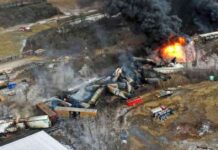South Korea and the US end multi-day air exercises. In the end, they once again demonstrate strength against North Korea. The self-declared nuclear power is also setting an example.
At the end of joint air exercises, the armed forces of the USA and South Korea once again demonstrated military strength against the self-declared nuclear power North Korea. For the first time in five years, the US sent B-1B long-range bombers to the Korean peninsula, South Korea’s general staff said on Saturday. Two of these supersonic bombers, along with eight fighter jets from both countries, took part in the “Vigilant Storm” exercises in South Korea, which ended after six days.
North Korea continued its missile tests the same day. According to the South Korean military, at least four short-range ballistic missiles were detected in the morning (local time) after the launch in North Korea. They flew about 130 kilometers towards the Yellow Sea.
It was not clear from the information whether the tests were carried out after the B-1B bombers flew over or before. In the past, the United States had repeatedly flown long-range bombers over South Korea as a sign of the strength of the alliance.
North Korea is currently testing missiles again at an unusually high frequency. According to the South Korean military, the country has already launched more than 25 missiles including an ICBM this week alone. The tests were also seen as a reaction to the air exercises in South Korea. North Korea accused both countries of “reckless provocation” and threatened countermeasures. South Korea and the USA also fear that North Korea’s first nuclear test in years could be imminent.
UN resolutions ban North Korea from testing both nuclear and ballistic missiles of any range that can be armed with a nuclear warhead.
But even at the ninth session of the UN Security Council this year on the subject of North Korea, the split in the body prevented action to be taken against the increasing tensions on the Korean peninsula. The 15 members of the most powerful UN body did not agree on a joint statement on Friday in New York. Instead, a number of countries — including the US, Britain and France — separately condemned Pyongyang’s missile tests.
A unified approach by the Council failed in the past due to resistance from China, which is seen as North Korea’s closest international partner. At the meeting on Friday, Chinese Ambassador Zhang Jun criticized, among other things, American-South Korean military exercises, which he believes are driving the spiral of escalation. However, he also stressed that Beijing was clearly opposed to any nuclear build-up on the Korean peninsula.















